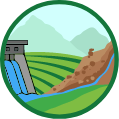Content
This guidance tool highlights the key elements for decision-making around landslide risk assessment and NBS to manage landslide risks. The Background section provides a broad overview of landslides, landslide risk assessment, and NBS to orient Bank teams to the kind of landslide risk they may be dealing with in their project area, and what the risk management tools may be. The next section, NBS Solutions for Landslide Risk, takes a deeper dive into the components and practice of landslide risk assessment, and discusses how teams may integrate NBS considerations into the assessment process. The final section, Case Studies, details five case study examples to highlight how NBS has been integrated into risk assessment and management in Bank projects. While there are other case studies of landslide risk assessment and NBS, this guidance tool has selected five implemented by the Bank in three practice areas. The case studies are drawn from the following sectors:



Disaster Risk Management (DRM)
Managing exposure of people and assets to landslide risk (GFDRR ThinkHazard; Africa National Landslide Risk Profiles; Sierra Leone Multi-City Risk Assessments)
Environment (ENB)/Erosion & Sedimentation
Managing impacts to agriculture, hydropower, and drinking water quality (Kaligandaki Case Study)
Transport/Roads
Managing impact of roads on landslide risk, and landslide events on roads (Afghanistan Roads DSS)
Case Study Examples Illustrating LRA
| Case Study | Sector | Scale |
|---|---|---|
| ThinkHazard (GFDRR) | DRM | Global |
| GFDRR Africa National Landslide Risk Profiles | DRM | National |
| Sierra Leone Multi-City Hazard Review and Risk Assessment | DRM | Sub-national: Urban (Freetown, Makeni, and Bo) |
| Kaligandaki Landslide Assessment | Environment | Sub-national: Landscape |
| Afghanistan Geohazard Roads Decision Support System | Roads | Sub-national: Project-level |
This guidance note focuses on how NBS can be used to manage landslide risk. This guidance note adds to the World Bank’s work on guidance around NBS by focusing on landslide risk management. While grey engineering methods are commonly used for landslide risk reduction, NBS are gaining traction as a potential cost-effective component of integrated solutions. NBS specific to landslide risk management include investments at both the watershed/landscape and site/project scale. Watershed-level investments include conserving, restoring or managing forests and wetlands to regulate water flows that can trigger landslides. At the site/project scale, NBS for landslide risk management includes installing vegetation to stabilize landslide- prone slopes.
This guidance tool shows how landslide risk assessment can be a vehicle through which to identify opportunities to integrate NBS and green infrastructure into project design. The guidance tool relies on literature, expert opinion, and three case studies in which Bank teams conducted landslide risk assessments and considered NBS.
Aligning LRA and NBS methods can be a win-win as LRA and NBS selection criteria rely on similar data and information for decision-making. Risk assessment provides data on a number of social, economic and environmental variables necessary for NBS plant selection. For example, LRAs require information on land use, hydrology, soil, topography and socioeconomic needs and they provide information on landslide risk levels and the nature of failure mechanisms, all of which are also required in selecting appropriate plant species for slope stabilization. Plant manuals are available to guide plant selection based on species characteristics, but these must be viewed in concert with site-specific and landscape social, economic, and environmental parameters.